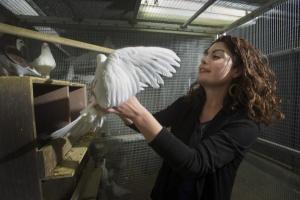By Eva Frederick

“In the past few decades, behavioral biologists have sought to apply our growing understanding of [animal] behavior to address societal problems including the loss of biodiversity, the toxification of Earth and the managing of human development,” said University of California, Los Angeles, ecologist Daniel Blumstein during a Feb. 17 session at the American Association for the Advancement of Science (AAAS) annual meeting. “These are multi-billion dollar problems, and they remain problems perhaps because of the lack of behaviorally sophisticated insights and solutions.”
One study found that feral pigeons can be reliable bioindicators of lead pollution in the environment.
When University of California, Davis, biologist Rebecca Calisi moved to New York some years ago, city officials recommended she test her then two-year-old daughter for lead poisoning. About 10% of New York City children have elevated lead levels, according to a 10-year analysis by Reuters published in 2017.
“That fascinated me as a researcher, but terrified me as a parent,” Calisi said. “I decided to think a little more about lead poisoning in our environment.”
She saw the need for a way to quickly and cheaply assess how much lead pollution is in a certain area, especially since not every city tests children’s lead levels.
And she saw birds.
Feral pigeons live closely with humans, share their food, water, and exposure to environmental toxins, and metabolize those toxins in similar ways. Calisi speculated that the birds, which generally restrict their day-to-day activities to relatively small areas called their home ranges, could help reveal the amount of lead pollution in those areas.
First, she compared pigeon lead levels from a Wild Bird Fund database with the lead levels in an existing database of New York City children. She overlaid this data on a map of the city and found that in areas where pigeons had higher blood lead levels, so did children.
Now that she’s demonstrated that the birds can be used as accurate bioindicators, her next step is to create tools that researchers, city officials and others can use to test pigeons and identify lead hot spots. She also plans to study whether the birds can be used in a similar way for other pollutants such as pesticides or fire retardants.
Using sound to save birds and agricultural assets
Birds are also playing a leading role in research aimed at protecting agricultural produce and equipment, airfields, and the creatures themselves.
When birds fly, the positioning of their eyes on the sides of their heads prevents them from seeing what’s right in front of their beaks. While this allows them to keep an eye on flock-mates and potential predators, it often causes them to collide with obstacles such as wind turbines and airplanes, leading to damaged machinery and plane crashes, not to mention their own deaths. Birds can also cause millions of dollars in crop losses. In New York, for example, the USDA estimates that fruit farmers lose more than $16 million in fruit crops each year due to bird damage.
Previous research shows that scare-and-startle bird-control methods such as scarecrows or mock plastic owls don't have the desired effect. Birds are frightened of the displays at first but soon learn they don’t pose a real threat.
“[This] is a good example of where we have tried various technologies, and we have shown again and again that they don’t work,” said John Swaddle, a biologist at the College of William and Mary. “They don't work because we are not figuring in the fundamental understanding of animal behavior.”
Instead, Swaddle used targeted noise to warn birds and keep them away from obstacles and produce. Noise of certain frequencies can prevent birds from hearing vital sounds from predators or others in their flock, so the creatures will retreat to a less noisy, safer-sounding spot. Swaddle studied the behavior of zebra finches to create two technologies that emit either wide nets of sound covering part of a farm or airfield or narrow noise columns directly in front of obstacles. Both systems use directional speakers to keep the sound — spanning 6 to 12 kilohertz, the upper end of birds’ hearing range — focused in one area to prevent additional noise pollution.
Both technologies were effective at causing birds to relocate or to avoid obstacles, and Swaddle’s next step is to market them.
These discoveries showcase real-world applications of basic biological principles.
“Without a fundamental understanding of what animals are actually doing and how they’re behaving, you can’t even develop these kinds of ideas,” Swaddle said. “People have to support foundational biology because much of this can be used for realistic and long-term solutions to these kinds of societal problems.”
Eva Frederick is a senior at the University of Texas at Austin studying biology and journalism. A former managing editor of The Daily Texan, she now writes for Texas Parks & Wildlife Magazine and teaches children about native plants at the Lady Bird Johnson Wildflower Center. Follow her on Twitter @EvaCharlesAnna or email her at evacharlesanna@gmail.com.

